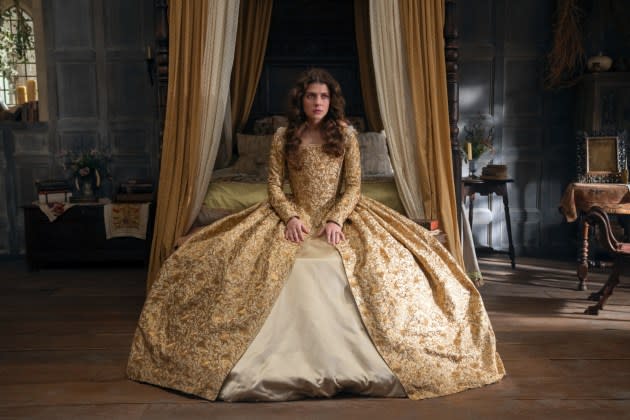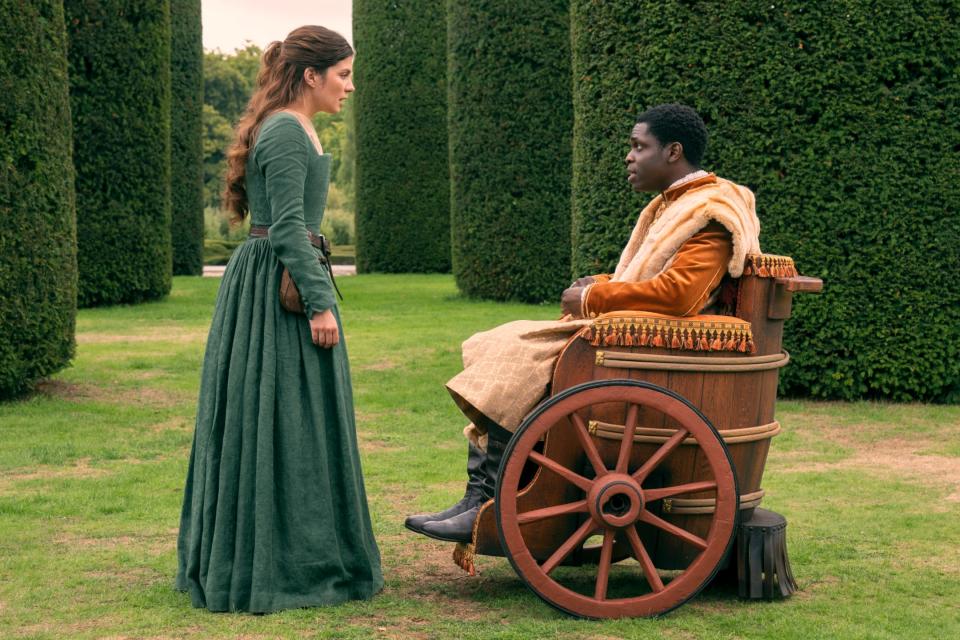‘My Lady Jane’ Cast, Writers on Bringing to Life the ‘Fascinating, Dramatic, Sexy’ Tudors and Turning History on Its Head

“My Lady Jane” may be chock full of corsets but this is not your average bodice ripper. A feminist retelling of the life of Lady Jane Grey – famous for being on the throne for a mere nine days before she got the chop (literally) – the series stars Emily Bader as a kickass Jane who dreams of running away from her overbearing mother and forced marriage to write a compendium about medicinal herbs.
The show, which drops today on Prime Video and is based on the books of the same name, also contains plenty of cursing (not the magical kind), anachronisms and a sprinkle of romantasy (a sub-plot involves persecution of people who can turn into animals at will). So it’s not surprising that showrunners Gemma Burgess and Meredith Glynn took delight in peppering the show with both Tudor and pop culture references including, in no particular order, Mark Smeaton (executed IRL for having an affair with Anne Boleyn), “Clueless” (look out for Bader’s note-perfect “As if!”) and “Buffy the Vampire Slayer.” More soberingly, given Henry VIII’s penchant for killing his wives, Burgess shares: “We name check a lot of women who were killed unjustly at the time.”
More from Variety
Prime Video's 'My Lady Jane' Is Outlandish, Ahistorical and a Great Bit of Fun: TV Review
'ER' Alum Gloria Reuben Joins Prime Video Drama 'The Better Sister' (EXCLUSIVE)
Despite the Tudors’ less than stellar record when it came to feminism (as Jane’s father-in-law points out, a woman was still considered her husband’s property), the combination of high-stakes court intrigue and sexual incontinence also makes it a period ripe for dramatization, including in series such as “Wolf Hall” and “The Tudors.” “It is such an exciting period of history,” acknowledges Edward Bluemel, who plays Jane’s romantic interest Lord Guildford Dudley. “It makes total sense so many stories are written about the Tudor period because it is genuinely fascinating and dramatic and sexy and violent and all of those things.”

Although set in the years immediately following King Henry VIII’s death, when his eldest but sickly son Edward (played by Jordan Peters) was on the throne, the show frequently departs from the historical record, not least in giving Jane more agency than she ever possessed in real life. “I think we were purposefully choosing the things that we wanted to be historically accurate, and then just totally rewriting Jane’s story,” says Bader.
On the historically accurate side are the costumes, courtesy of designer Stephanie Collie (“Peaky Blinders”), who rustled up sumptuous ballgowns, breeches and, of course, plenty of corsets. For Bader, who describes herself as “more of a flip flop, giant t-shirt” kind of woman, the clothes were a challenge in and of themselves, requiring the best part of an hour to get on each morning. They also helped her get into the mindset of a future Queen of England. “You can’t be slouchy [in a corset],” she points out. “You can’t have bad posture, which for me, was a blessing. Because I can just hear my mom being like, ‘Emily! Shoulders back!’
Elsewhere, like “Bridgerton” and “Catherine the Great,” the show has no apologies about turning history on its head, including in both the dialogue (the first 30 seconds of the show include this exchange: “If his member looks pustular — ” … “Don’t shag him!”) and the music, which veers from “Tainted Love” to Alice Merton. And of course there’s the story itself. “Jane could have been the leader England needed,” the narrator says in the opening montage. “But instead history remembers her as the ultimate damsel in distress. Fuck that. What if history were different?”
Burgess and Glynn both admit to being “obsessed” with the real Jane Grey, with Burgess attributing her fascination to Paul Delaroche’s nineteenth-century painting, which depicts Jane, blindfolded, as she’s led to the executioner’s block. “She’s so beautiful and it’s slightly sexually titillating in this weird way,” Burgess says. “And she’s so vulnerable and doomed. When you’re very young you think that’s very romantic and then you get older, and you realise she was an absolute pawn, she was murdered. It’s pretty terrible. Let’s change that story.”
Deliberately eschewing history can be “freeing,” Glynn agrees. “To be able to use that time period to tell modern stories, especially the modern stories about being a young woman — about love, about sex, about friendship — that was really important to us.”
Best of Variety
Sign up for Variety’s Newsletter. For the latest news, follow us on Facebook, Twitter, and Instagram.


